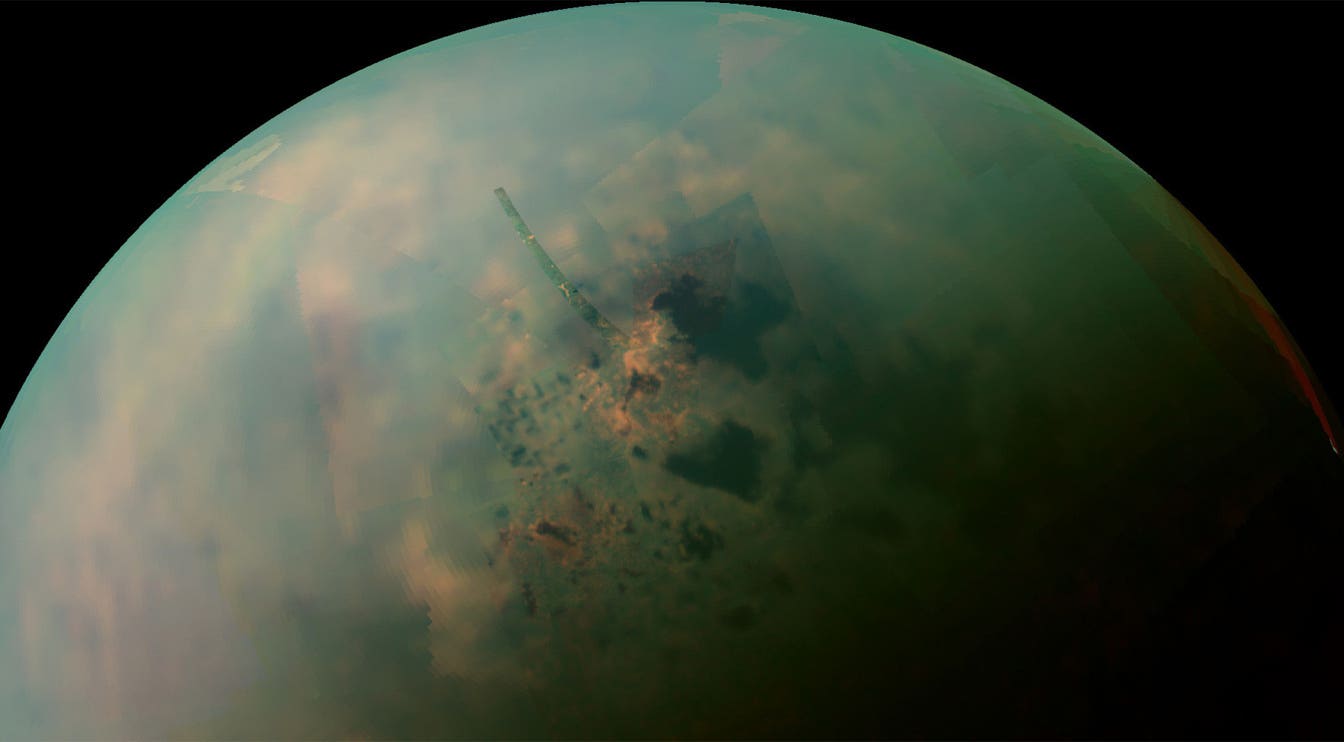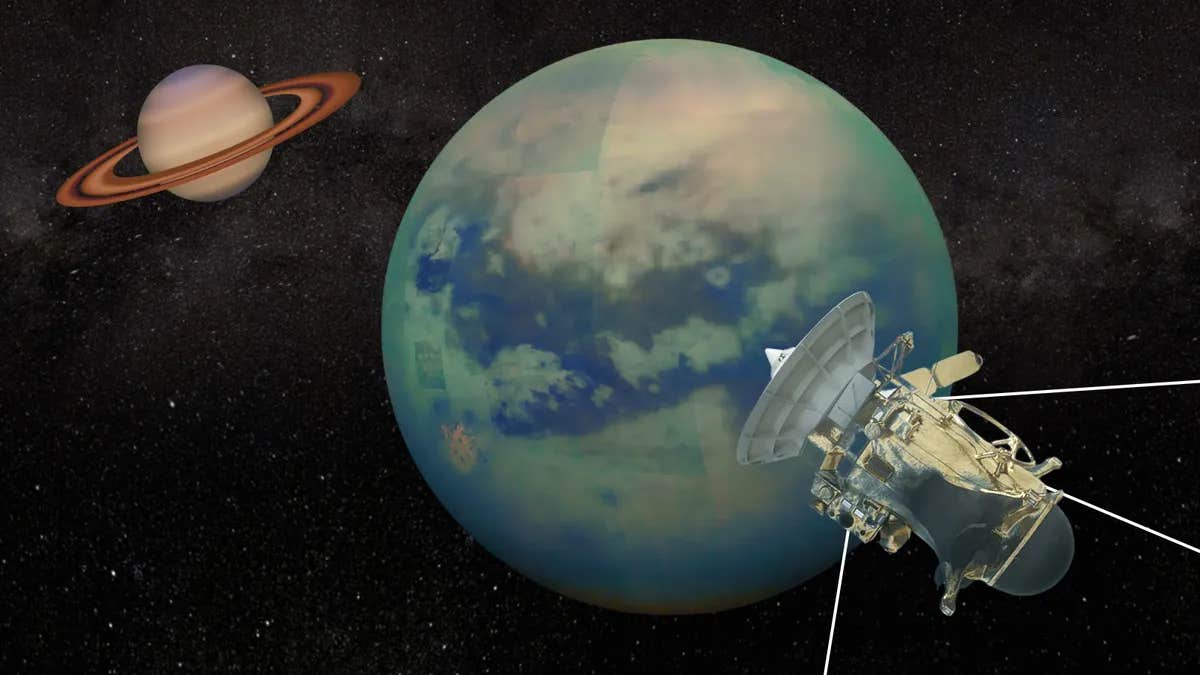Saturn’s largest moon Titan has a baffling atmosphere that wobbles and spins like a gyroscope
Titan’s atmosphere tilts and wobbles like a gyroscope, shifting with the seasons and surprising scientists with new mysteries.

Saturn’s largest moon doesn’t spin like Earth. Instead, Titan’s atmosphere tilts and shifts with the seasons, baffling scientists and shaping NASA’s next big mission. (CREDIT: CC BY-SA 4.0)
Saturn’s moon Titan has always stood out among the celestial bodies in our solar system. It is the only moon with a thick, hazy atmosphere, and it's often compared to a primitive Earth. But now, thanks to a team of researchers at the University of Bristol, we know this alien world is even more mysterious than we thought.
Using data from NASA's Cassini spacecraft, which orbited Saturn from 2004 to 2017, scientists have found that Titan’s atmosphere doesn’t spin in sync with its surface. Instead, it wobbles like a gyroscope and shifts with the seasons. This behavior is unlike anything we’ve seen in other planetary bodies, and it raises new questions about atmospheric dynamics far beyond Earth.
A Tilted, Shifting Atmosphere
Over 13 years of thermal infrared measurements from the Cassini mission revealed a fascinating detail: Titan’s atmosphere tilts, and this tilt isn’t fixed to the planet’s rotation. It appears to be stable in space, as if the atmosphere is rotating around an axis that stays put while the moon itself turns underneath.
"The behaviour of Titan’s atmospheric tilt is very strange," said Lucy Wright, the study's lead author and a researcher at the University of Bristol. "It appears to be acting like a gyroscope, stabilising itself in space."
Titan completes a full orbit around Saturn every 16 days, but due to Saturn's tilted axis, each season on Titan lasts about 7.5 Earth years. The tilt in the atmosphere shifts with these long seasons, making the behavior even more unusual. Wright and her team found that the tilt is largest at certain times of Titan’s year and smallest at others, cycling between about 2.5 and 8 degrees.
Professor Nick Teanby, a co-author of the study, added, "What’s puzzling is how the tilt direction remains fixed in space, rather than being influenced by the Sun or Saturn. That would’ve given us clues to the cause. Instead, we’ve got a new mystery on our hands."
Related Stories
Super Winds and Polar Vortices
Titan’s entire stratosphere is in a state of superrotation. This means that the winds in the upper atmosphere travel far faster than the surface turns. In fact, these winds can be up to 20 times faster than the moon's rotation. This is similar to what scientists see on Venus, but on Titan, it occurs in a nitrogen-rich atmosphere with a touch of methane.
The research team used a special infrared tool aboard Cassini called the Composite Infrared Spectrometer (CIRS). It measured Titan’s temperatures and helped create detailed maps of the atmosphere. With this high-resolution data, the researchers discovered features like fast-moving winds, seasonal jet streams, and polar vortices — huge swirling air masses near the poles.
During Titan's winter, a strong circumpolar jet forms around the cold pole, much like Earth's polar vortex but with unique features. The polar region becomes packed with trace gases and gets colder due to long-wave cooling. The vortex acts as a barrier, keeping gases trapped and creating temperature differences of up to 50 degrees Kelvin between the pole and the equator.
This vortex might even form a donut-like ring around the pole for part of the season. The presence of these jets and complex wind patterns suggests Titan has one of the most dynamic atmospheres in the solar system.
Aiding Future Missions
These findings don’t just help us understand Titan’s weather. They’re also critical for upcoming missions. NASA plans to send the Dragonfly mission to Titan in the 2030s. Dragonfly is a drone-like aircraft designed to fly through Titan's thick atmosphere.
Since the atmosphere isn’t stationary and tilts with the seasons, scientists must now factor this wobble into their landing plans. The winds will carry Dragonfly as it descends, and if the atmosphere is misaligned with the surface, it could affect its path.
"Understanding how the atmosphere wobbles is crucial for calculating Dragonfly’s landing," said Dr. Conor Nixon, a planetary scientist at NASA and co-author of the study. "This research helps us predict where it might land more accurately."
A Glimpse Into Alien Weather
The research team found even more surprises. By using new temperature maps with higher resolution than any previous study, they could track how Titan's polar vortex forms and breaks apart. They saw not just one strong jet during winter, but sometimes two. In Titan’s summer hemisphere, they found a weaker jet that hadn’t been clearly seen before.
Their paper, published in The Planetary Science Journal, also shows how Titan’s atmosphere is a natural lab for studying atmospheric science. Many of its features mimic Earth's in shape, but not in cause. While Earth’s winds and weather are driven mostly by sunlight, Titan's patterns seem to have a different driver that scientists haven’t yet uncovered.
Cassini's instruments also showed how trace gases, such as methane and more complex organic molecules, build up and move through the atmosphere. These chemicals act as markers for air flow. Some settle in the poles due to circulation patterns that push gases downward in winter and upward in summer.
Titan's atmosphere has long fascinated scientists because it's full of complex chemistry. About 98% of it is nitrogen, with 1% to 1.5% methane. When sunlight hits the upper layers, it kicks off reactions that form heavy hydrocarbons and nitriles. These molecules are believed to be similar to the building blocks of life on early Earth.
Titan's seasonal cycle is shaped by Saturn's 26.7-degree tilt, which is similar to Earth’s 23.5 degrees. This means that just like Earth, Titan experiences seasons. As a result, general circulation models predict Titan has one giant circulation cell for most of its year, with air rising at the summer pole and sinking at the winter pole.
Around equinoxes, this pattern flips and creates two circulation cells for about two Earth years. These predicted changes match what scientists saw with Cassini’s observations.
"Our work shows that there are still remarkable discoveries to be made in Cassini’s archive," said Dr. Nixon. "This instrument, partly built in the UK, journeyed across the solar system and continues to give us valuable scientific returns."
The research by the University of Bristol offers more than just a deeper look into Titan. It pushes forward our understanding of how atmospheres behave across the universe. By watching Titan, scientists can test models that apply to Earth and other worlds too. The team’s work adds another chapter to the story of how planets breathe, change, and move through time.
Note: The article above provided above by The Brighter Side of News.
Like these kind of feel good stories? Get The Brighter Side of News' newsletter.



